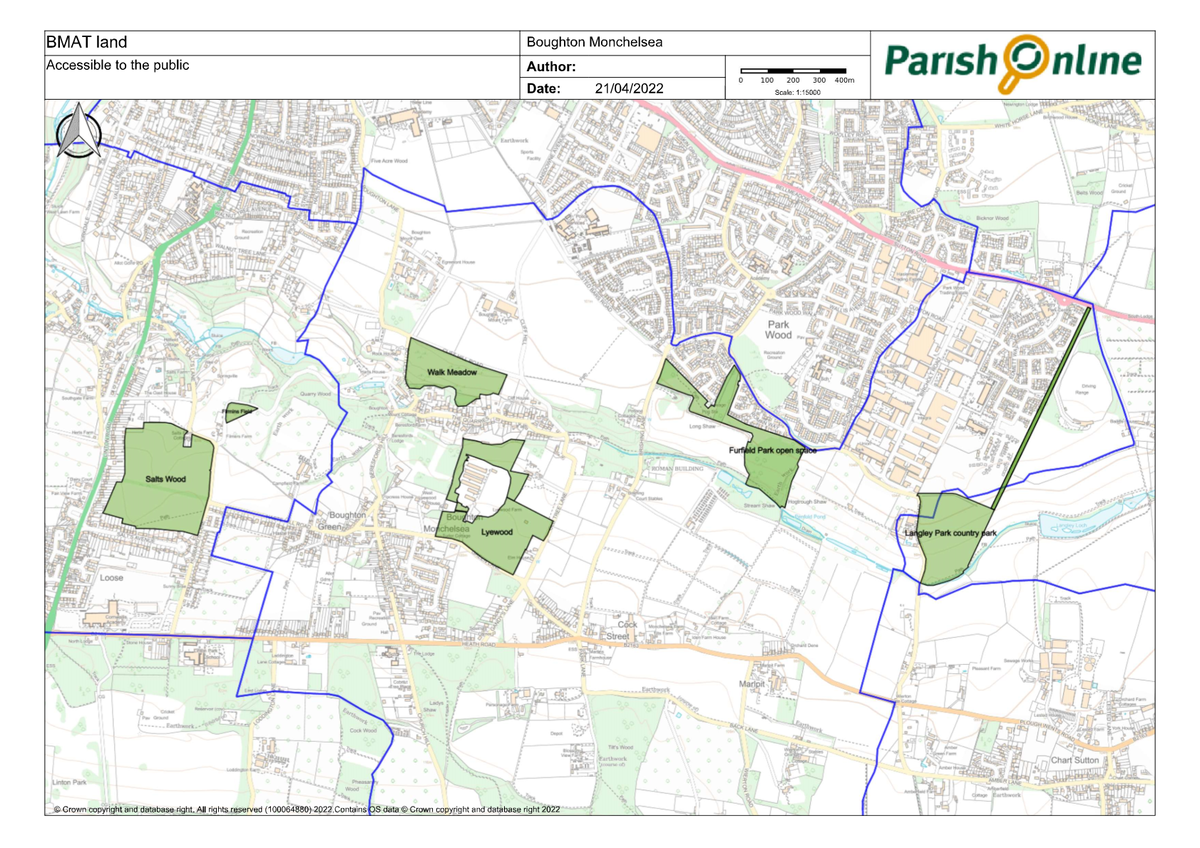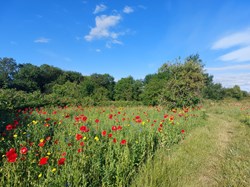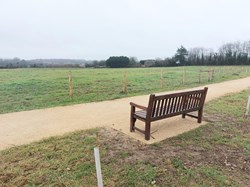Overview

Boughton Monchelsea Amenity Trust (BMAT) was established in the 1980's and set up by the Parish Council as a vehicle to hold and manage land and assets on behalf of the parish with the objective of protecting, as far as possible, our open countryside and environment from excessive and inappropriate development, and in particular, Maidstone's south eastern urban sprawl.
Over 30 years on, BMAT now owns or has option agreements on approximately 300 acres of land in and around the parish, some of which is leased back to farmers and will continue to be farmed for years to come. The remainder of the land is public open space and accessible to all parishioners and the general public. All this land is controlled by BMAT such that it is protected from inappropriate development.
BMAT continues to be active in identifying further opportunities to protect Boughton Monchelsea and engaged a specialist landscape consultant in 2017 to prepare a Masterplan and Management Plan to co-ordinate and maintain the land under BMAT's control. A presentation on this was given at one of our Parish Meetings and can be viewed below.
Boughton Monchelsea's Neighbourhood Plan acknowledges and embraces BMAT's aims and objectives whilst recognising the need to accommodate appropriate new development in our progressive, forward looking parish community.
The land owned by BMAT also provides a great opportunity for projects aimed at addressing the climate change and biodiversity emergencies. Currently around 100 acres of land is dedicated to these projects.
In November 2019 BMAT trustees agreed to support the Parish Council in its recognition of global climate and bidoversity emergencies and the following response was returned to MBC in response to a request for ideas and thoughts on what could be done to protect and enhance biodiversity across the borough and to address climate change impacts.
On 19th September 2019
Boughton Monchelsea Parish Council :
(1) Declared its recognition of global climate and biodiversity emergencies;
(2) Supported Maidstone Borough council in its ambition for the whole of the Borough of Maidstone to be carbon neutral with a target date of 2030
(3) In addition, the Parish Council will support Boughton Monchelsea Amenity Trust (BMAT) in its current plans to re-wild and carry out tree planting on its existing land, to enhance species, habitats and the ecosystems where practical and appropriate, this would including any land acquired by the trust in the future.
A. LOCAL INITIATIVES AND IDEAS
1. Land management for biodiversity gain and climate change mitigation
As a result of recent reports and evidence with other organisations and authorities recognising both the Climate Change and the Biodiversity emergencies Boughton Monchelsea Amenity Trust (BMAT) have decided help to address these critical situations using their current and future land holding where available and practical.
Objectives of the BMAT biodiversity project in order of importance:
1.To contribute to climate change mitigation by acting locally to impact on outcomes
2.To support greater biodiversity.
3. To increase and enhance natural habitats.
2.To enhance health and wellbeing of residents by improving access to greenspace, encouraging exercise and improving air quality.
4. To enhance flood resilience and reduce drought impact.
5. To support improved contact with and understanding of nature.
Available land
BMAT has a total land holding of around 325 acres with 216 acres on long leases that restrict activities on this land to agricultural practices only. This would leave around 74 acres in 7 locations currently available to the project with a further 35 acres in three locations being made available to the project in the near future, once developers are off site. While each one of these sites already offer different opportunities to achieve the BMAT project objectives it is important to remember that these sites are connected by “green corridors”. The sites include areas of established woodlands which including ancient woodland, areas of rewilding as well grassland which is suitable for flower meadows. Currently one area of 32 acres is going forward for the government’s carbon grant that is currently planned to be planting 2020/21. The challenge will be maintenance and maximising environmental impact whilst also ensuring the community benefits.
Boughton Monchelsea has an active allotment group who have proposed they manage some of the land allocated for allotments in a wildlife friendly way.
2. Transport and travel
The PC is about to introduce its own 20mph limits within the parish, at their own cost.
EV charging points will be provided in new developments.
Within the NHP there is a comprehensive network of cycle routes and safe walking routes planned
3. Energy Generation and saving
The PC would like to support a community energy generation scheme.
4. Waste and litter
The parish has worked hard to provide plenty of rubbish bins and dog waste bins. It organises a twice-yearly village litter pick and has a group of around 30 regular volunteers who ensure very little waste enters the watercourses. It is planning with MBC a public education campaign using signs which are clearly visible to motorists to reduce the amount of litter discarded.
5. Community Engagement
Boughton Monchelsea primary school was one of the few in the county to take part in the School Strike for Climate which engaged several children and their families.
The local community will be invited to take part in tree planting and other activities to restore nature across the BMAT estate.
Boughton Monchelsea Parish Church is registered for Eco Church and has beautiful wildflower area in the church yard (God’s Acre project)
6. Flood and drought mitigation
Boughton Monchelsea has experienced significant flooding in the past and is therefore is likely to be at increased risk in the future from flooding in spite of the reservoir that has been used to effectively manage that risk in recent years. The parish also has a lot of sloping very well drained land, so drought is also a risk. Tree planting, additional hedgerows and good soil management have all been employed to improve the water cycle and will be increased as part of the BMAT plans.
B. IDEAS TO INFORM MBC ACTION PLAN
1. Land Management and biodiversity
A borough plan joining up all areas providing good natural habitat, forming part of the national programme for Nature Recovery Networks. A clear scheme linking the forthcoming requirement on developers to provide 10% biodiversity net gain to joined up schemes for nature across the borough.
More green roofs in town to promote biodiversity, provide insulation, help with cooling in summer and preventing water run-off.On MBC offices? If not then solar panels
Green bridges or tunnels across motorways and railway lines to prevent “islandisation” for terrestrial animals. Likewise mandating hedgehog holes in fencing around new housing developments. Swift boxes and bat boxes incorporated into new developments.
Scheme to encourage gardeners and farmers to restore soil health using organic matter.
MBC could also encourage more pollinator friendly wildflower planting in town parks, roadside verges and in public spaces where lawns are currently mown regularly - this would reduce costs and the MBC carbon footprint.
A dark skies policy reducing artificial light across the borough at night with enforcement to protect nocturnal animals and birds while reducing energy use.
2. Transport and Travel
Well designed network of EV charging, including at station car parks and all shopping centre.
Joined up cycle and walking routes across the borough, safely separate from roads wherever possible.
Cycle loan scheme in town
Ultra low emissions zone (ULEZ)
School carparks could be located a few hundred yards from the school off the road with a safe green walk way for parents and children – triple benefit: reduced air pollution around the school, more exercise and fresh air for children, experience nature twice daily.
3. Energy generation and saving
A borough wide scheme for local renewable energy generation as proposed in the , with profits being used in the community.
All new housing to be carbon neutral.
There is a lot of scope for more solar PV on warehouses and other large buildings avoiding the problem of using agricultural land for energy - can the appropriate incentives be looked at for this?
Energy switching schemes should promote insulation and “green” energy.
4. Waste and Litter
Standardised waste bins across MBC with options to recycle and clear instructions.
Better information on domestic waste bins (wheelie bins) as many people remain confused about recycling rules. It needs to be regularly reissued and reinforced as people move into the area. Information about what happens to the waste and the environmental benefits from careful sorting would be very helpful as some people are still cynical about the ultimate destination of recycling waste.
5. Community Engagement
It would be wonderful to have a bespoke education and engagement package (ideally interactive) for local communities which can be deployed in a variety of settings- e.g. WI meetings, faith groups, gardening societies etc.
More support to encourage “green” business and agriculture eg eco-tourism and local energy schemes – perhaps a loan scheme to help start ups if addressing the climate and ecological crisis.
6. Flood and drought mitigation
Land management to provide more natural solutions (trees, hedges, river meanders, wetland areas) to increasingly likely heavy rainfall, especially on high ground. A programme of interlinked ponds and waterways, ideally with beavers to naturally engineer the rivers. Leaving vegetation standing over the winter. Green roofs should be encouraged. Water use education and encourage grey water recycling.A robust approach to water leaks. Ensuring healthy soil management including more local recycling of organic waste into soil improvement, encouragement of agro-ecology schemes which benefit the water cycle.
Boughton Monchelsea Parish Council welcomes this opportunity to input into Maidstone Borough Council’s plans to tackle the climate and ecological emergencies and is keen to work cooperatively and with all speed on this agenda.


